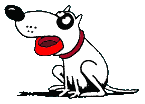
"Dog Food"
Updated: 2008

"Dog Food" Updated: 2008 |
|
Important for all to read and keep updated on... no matter what dog food you feed. Seems like NONE of us are safe! They have now stated that some companies were adding these Glutens, such as the RICE PROTEIN CONCENTRATE to some dog foods and not listing them on the labels... Who's safe???? NONE OF US ARE, PERIOD!!!!!! This article is very scary and highlights what I view as the biggest problem which was the delay in alerting the public.... http://sfgate.com/cgi-bin/article.cgi?f=/g/a/2007/04/03/petscol.DTL
This is a list of pet foods that have NOT been recalled. http://www.thepetfoodlist.com/ EVEN FOODS ON THIS LIST ARE 100% SAFE, NONE OF THEM ARE IF YOU REALLY THINK ABOUT IT. |
|
Poor Quality Nutrition Is An Important Factor When people shop for dog food, most are looking for bargains. They aren't really thinking what is the best I can buy for my dog, but they are thinking *What is the best I can get for the cheapest price*. Does dog food quality matter? Dr. P. F. McGargle, a vet and former "federal meat inspector" believes that feeding slaughterhouse waste to pet animals increases their chances of getting cancer and other degenerative diseases (we are what we eat, right?). He said, “Those wastes include moldy, rancid, or spoiled processed meats, as well as tissues too severely riddled with cancer to be eaten by people”. Combine this with the sodium pentobarbital from euthanized animals, pesticides from the carcasses of rendered animals, residual cattle antibiotics and growth hormones (all found in the protein sources of cheaper dog foods), and it becomes obvious that we must carefully choose the foods we feed our sensitive Greyhounds or their lives could be dramatically affected".... SHOULDN'T
THIS APPLY TO OUR BULLDOGS??? How much more does it cost to feed
a premium food versus a cheap or grocery store brand? One difference between
the super-premium pet foods and the grocery store brands is that the super-premium
brands are highly digestible, meaning more of the pet food actually stays
in the animals body. The animal doesn't have to eat as much to maintain
its body weight and excretes less waste.” For not that much more
per year, you can feed a premium food versus a grocery store/discount store
brand dog food, and you can give your dogs it's best chance at a longer,
healthier life, and pick up fewer pounds of dog poop each month. Lower
vet bills due to a reduction in illnesses such as allergies, skin problems,
and intestinal problems make the feeding of premium dog foods even more
financially attractive.
|
|
|
||||
Now
you tell me it doesn't matter what you feed them???
|
|
update: WE ARE FEEDING RAW & HOMECOOKED FOOD! We no longer trust or endorse any dog food company, but we will keep this page up for others who continue to feed kibble. 
One of our large Healthy Litters... 11 pups... 11 Hungry little Monsters lol |
|
Yogurt, we give them some after we de-worm them to coat their stomach and Intestines because the wormer can strip the lining of the gut and may give some pups diarreah...
|
|
|
|
|
UNDERSTANDING THE LABELS |
|
|
|
|
| POOR
PROTEIN SOURCES |
Soybean
Meal, Wheat, Corn Glutens, Rice Protein Concentraite, Rice Gluten, Corn
Meal, Whole Corn, Crushed Corn and Ground Corn are commonly used for their
protein content in many pet foods. These ingredients are generally
poor sources of protein vs. meat
*HIGH PROTEIN FOODS ARE USUALLY MADE UP FROM THESE SOURCES. HIGHER PROTEIN DOESN'T EQUAL BETTER... LOOK WHERE YOUR PROTEIN SOURCES ARE COMING FROM!!! |
| CHEMICAL PRESERVATIVES | BHA, BHT and ethoxyquin are found in many pet foods. Scientific studies have proven that these chemicals can be harmful. In fact, they have been shown to promote liver disease and other medical problems. |
| FOOD COLORING | Food colorings are still commonly used in pet foods today despite the fact that they are not necessary and some have been linked to medical problems. |
| BY-PRODUCTS | By-products
can vary ... they can consist of the internal parts of animals such as
necks, heads, undeveloped eggs, feet, intestines, lungs, spleen and liver.
Although by-products are used by many manufacturers, are these ingredients
you would knowingly feed your pet?
Meat By-Product: Clean, non-rendered parts other than meat of slaughtered mammals. This can include lungs, kidneys, brain, spleen, liver, bone, blood, stomach, and intestines freed of their contents. It does not include hair, teeth, hooves or horns. Poultry-By-Products: Clean, non-rendered parts of slaughtered poultry, such as heart, lungs, liver, kidneys, feet, abdomen, intestines, and heads free of fecal content and foreign matter except in such trace amounts as might occur unavoidably in good factory practice. Poultry By-Product Meal: Round, rendered, and clean parts of slaughtered poultry, such as undeveloped eggs, necks, feet, and intestines. It does not contain feathers except those which are unavoidable during processing. |
|
|
The hard white fatty substance which is rock hard and looks like a bone. Most dogs have great difficulty digesting this substance. In general, ingredients that are listed with a generic source (“animal digest”, “meat and bone meal”, etc.) have been rendered or derived from 4D meat, roadkill, zoo animals, euthanized pets, etc., and should be avoided. Ingredients that list specific sources, like “chicken by-product” or “lamb digest” will contain only chicken or lamb, and are likely to be safer for your pet. |
|
|
Obtained from the tissues of mammals and/or poultry in the commercial process of rendering or extracting. Also sourced from restaurant grease. Often preserved with BHA, BHT and Ethoxyquin. |
|
|
A powder or liquid made by taking clean under-composed animal tissue and breaking it down using chemical means. |
|
BONE MEAL: |
Rendered meal made from animal tissue and bone. At the rendering plant, slaughterhouse material, restaurant and supermarket refuse, dead-stock, roadkill, and euthanized companion animals are dumped into huge containers. A machine slowly grinds the entire mess. After it is chipped or shredded, it is cooked at temperatures of between 220 degrees F. and 270 degrees F. for twenty minutes to one hour. The grease or tallow rises to the top, where it is skimmed from the mixture. This is the “animal fat” seen in the ingredients of some pet foods. The remaining material is then put through a press to squeeze out the remaining moisture, and titled “meat and bone meal” (The second ingredient in “Ol’ Roy.. Ol Roy have actually received Class Action Lawsuits against them, but some of you are still too cheap and continue to buy this garbage.”). |
|
WHAT LABELS
DON'T REVEAL Consider this example: You decide to eat a balanced meal. You order a fast food hamburger, which contains protein from meat, carbohydrates from bread and vegetables from tomatoes. The three food groups. The next night your mom prepares the same balanced meal but her hamburger is made with premium grade sirloin meat, whole wheat bread and fresh garden tomatoes. While the ingredient list for both dinners would read the same, obviously mom's meal provides a higher level of nutrition.
|
Condemned
parts and animals rejected for human consumption can be rerouted into commercial
pet foods. These condemned parts are referred to as the 4 D's: dead,
dying, diseased or decayed. We believe this is one of the most
despicable practices in the pet food manufacturing industry.
Some manufacturers have a lower standard regarding the quality of ingredients they use to make pet food. A recent example of this practice is the discovery of Pentobarbital in major pet foods, including supermarket brands. Pentobarbital is a chemical used to euthanize animals. Many holistic veterinarians feel that daily ingestion of pentobarbital can be harmful. Many manufacturers cut costs by using the cheapest ingredients available at the time a food is made. Since costs rise and fall, some manufacturers will vary ingredients from batch to batch .. resulting in changed nutrient values for each batch and possible digestive illness. Some manufacturers have lower standards regarding the freshness of ingredients they use to make pet food. You can not determine the freshness of ingredients by reading a label; you must trust the pet food manufacturer.
|
|
|
"Comparing Dog Food Labels" |